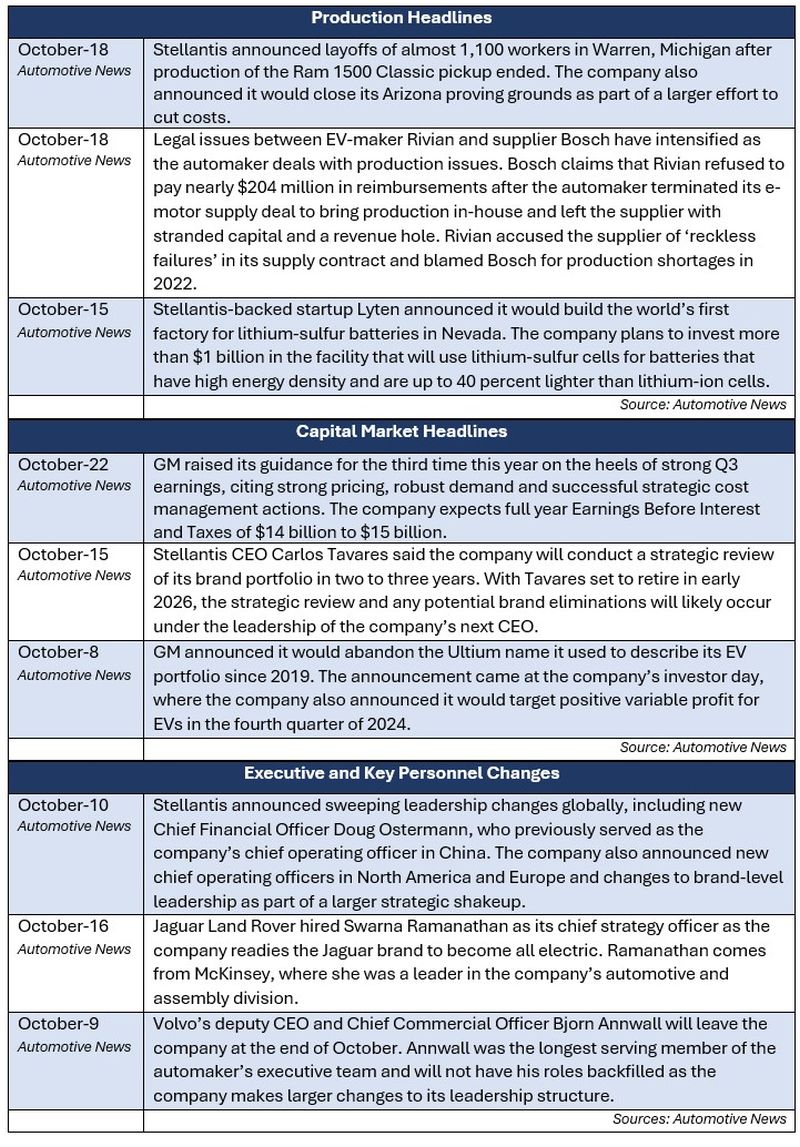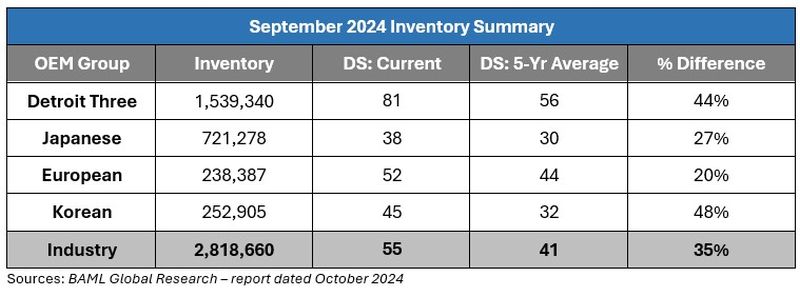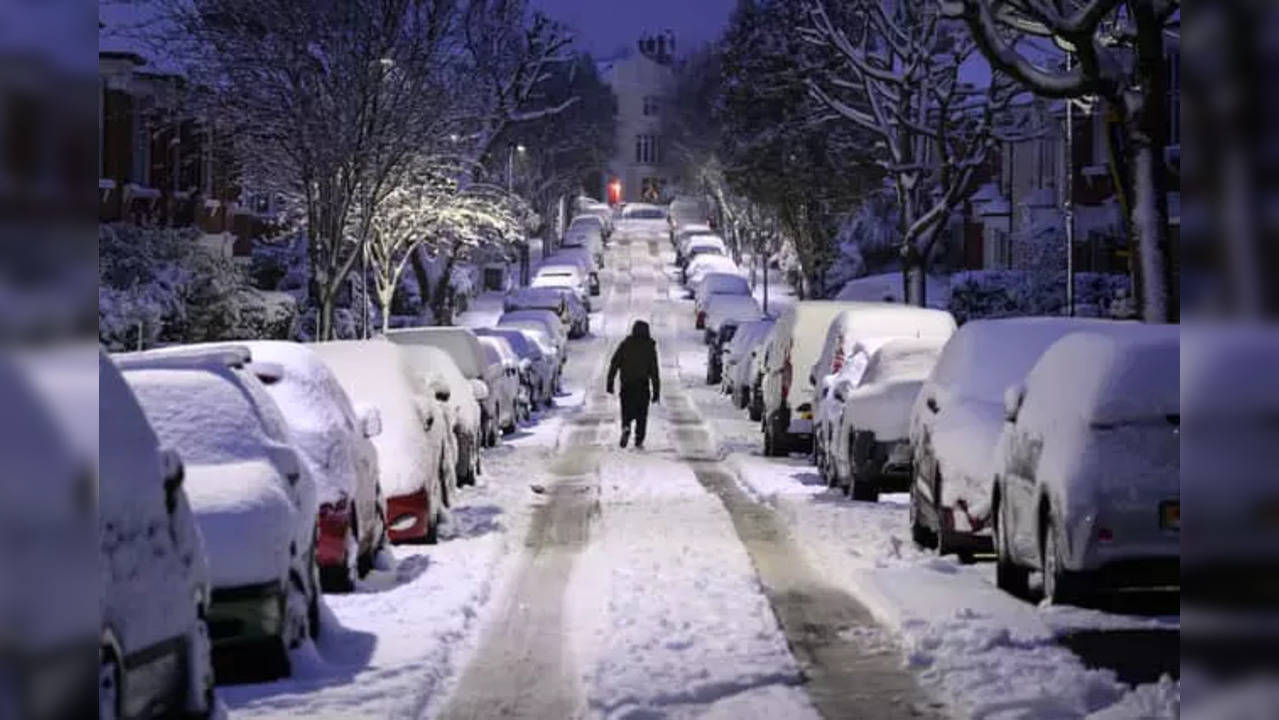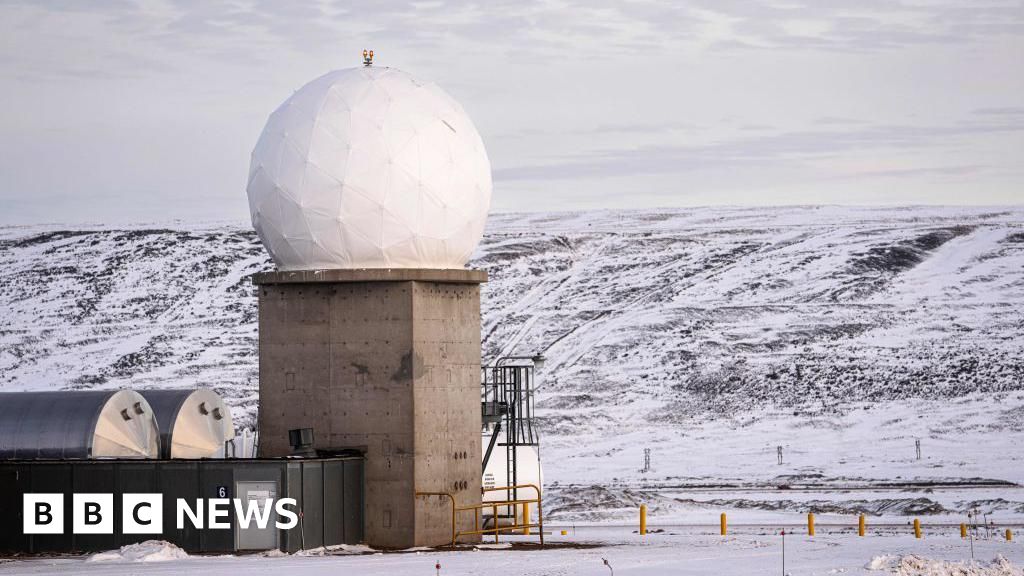Infra
A Look Into The Current State Of EV Charging Infrastructure In The U.S.

This edition of the Automotive Industry Spotlight will focus on
the current landscape of electric vehicle (EV) charging
infrastructure.
In industry news, the $204 million Rivian and Bosch
dispute escalates as Rivian faces production issues.
GM raises 2024 earnings guidance for the third time this
year, citing strong pricing, robust demand and successful
strategic cost management initiatives. Stellantis announces
sweeping leadership changes globally, including new COOs
across North America and Europe amidst broader changes to its
leadership structure.
In regulatory news, BMW announces a recall of 700,000
vehicles in China related to a coolant pump defect, which
could result in potential fire risk. The National Highway
Traffic Safety Administration (NHTSA) launches an investigation
into Tesla’s full self-driving software due to four
reports of collisions linked to the software. Honda
announces a recall of 1.7 million North American vehicles,
citing steering difficulties resulting from an improperly produced
steering gearbox.
Industry Focus: EV Charging Infrastructure in the U.S.
As excitement around EVs cools, one thing is clear: the lack of
robust public charging infrastructure continues to be a major
barrier to mass adoption. Consumers still hesitate to make the
switch, citing the infamous “range anxiety”1
— the fear that they won’t be able to find an operable
charging station before their battery runs out. In addition,
consumers dread the prospect of having to wait thirty minutes or
more for their vehicle to charge. For years, automakers and
government agencies have been pushing forward initiatives to change
that, but lots of roads will need to be covered to meet larger EV
charging goals.
Government programs, like the Bipartisan Infrastructure Law,
have funneled billions into EV infrastructure. Automakers are
continuing their own investments into solutions for the problem as
well, partnering with charging networks to make EVs more
convenient. Still, the current state of charging infrastructure
suggests we’re far from the goal of making charging stations as
ubiquitous as gas stations. Stakeholders across the EV supply chain
anxiously await the results from the 2024 U.S. presidential
election, which could result in very different outcomes for the
broader EV market.
The Road to 500,000 Charging Ports
The Bipartisan Infrastructure Law, passed in 2021, allocated
$7.5 billion to help states build the infrastructure needed to
reduce range anxiety and push EV adoption. Of that, $5 billion was
set aside for the National Electric Vehicle Infrastructure (NEVI)
plan. NEVI aims to establish EV charging stations every 50 miles
along major U.S. highways, with a target of 500,000 chargers by
2030.2
The most recent data from the U.S. Department of Energy reports
that there are only about 67,000 public charging stations
nationwide, which house approximately 187,000 chargers.3
However, only about 79,000 public chargers are active across the
US.3 In order to meet the goal of 500,000 public
charging ports by 2030, the number of EV chargers would need to
increase at a compounded annual growth rate of nearly 36 percent
between now and 2030; the average annual growth rate between 2014
and 2023 was 22.4 percent.3 Furthermore, the Bipartisan
Infrastructure Law allocates responsibility to the states for
building out EV infrastructure, and most states are falling behind
on their respective targets. The following map illustrates the
progress states have made toward their share of establishing the
alternative fuel corridor on interstate highways.
Even with billions in federal funding and original equipment
manufacturer (OEM) investment, there are regulatory and logistical
hurdles that make building out charging infrastructure a slow,
often frustrating process. Installing a public charger involves
navigating a maze of permits, approvals and zoning laws, and delays
are common. Additionally, states are inconsistent in how they
prioritize EV infrastructure, leading to disparities in progress.
Some states, particularly those in the Midwest and South, lag more
EV-friendly states like California.
Policymakers are trying to address some of these issues. For
instance, the Department of Energy recently announced a conditional
$1.05 billion loan guarantee for EVgo, an EV charging
infrastructure company, to deploy 7,500 charging ports across 1,100
U.S. charging station locations.4 This move aims to
accelerate the installation of charging infrastructure, including
fast charging technology, but OEMs and other private stakeholders
continue with their own initiatives.
OEMs and Charging Providers
While government programs and incentives will provide a
meaningful impact to EV charging infrastructure over time, OEMs and
other stakeholders will need a faster solution to hopefully aid in
reversing sluggish EV demand. Several major OEMs have struck deals
to improve EV charging access. For example, last year Ford
announced a partnership with Tesla, giving Ford EVs access to
Tesla’s extensive supercharger network.5
Additionally, GM has teamed up with Pilot Company — the
interstate travel and fuel center operator — to install up to
2,000 high-power fast chargers along U.S. highways in plans for a
coast-to-coast EV charging network.6
The addition of new charging ports and stations will continue to
be positive momentum for broader EV adoption, which should benefit
the OEMs by way of increased EV sales over time. Acknowledging
this, the need for standardized charging technology has also been
identified as a key area for development. As a result, most of the
major OEMs and third-party charging infrastructure providers have
made the commitment to adopt the North American Charging Standard
(NACS) inlet on their future production of EVs and charging
ports.7 Prior to this commitment, there had been a
variety of charging inlets on the market, which furthered the issue
of range anxiety as compatibility with chargers was not standard.
Collaboration among OEMs and third-party charging infrastructure
providers should continue over the next several years of
infrastructure build up and all stakeholders, including consumers,
should realize benefits from increased standardization and
accessibility in EV charging infrastructure.
2024 Presidential Election: A Potential Sea of Change
With the 2024 U.S. presidential election coming soon,
stakeholders across the automotive industry are anxiously awaiting
the results to react to potentially significant policy changes.
Automakers and suppliers alike have delayed key EV investment
decisions until after the results of the election are
finalized.8 Our previous coverage on the topic noted
that a Harris/Walz administration would likely continue the Biden
administration’s rules on vehicle emissions, which are
estimated to require electric vehicles representing between 30
percent and 56 percent of vehicle sales by 2030-2032.9
Meanwhile, a Trump/Vance administration would likely significantly
change emission guidelines, resulting in less pressure on
automakers to ramp up EV production and reduce production of
internal combustion engine (ICE) vehicles. Furthermore, former
President Trump has indicated he sees a much smaller market in the
near- to mid- term future for EVs due to the losses most OEMs are
incurring on EVs and battery range issues.10
The momentum behind EVs and supporting infrastructure could
change drastically depending on the outcome of the presidential
election. The large-scale buildout of a national charging network
would reliably continue under a Harris/Walz administration, and
OEMs and others in the EV supply chain would potentially receive
continued increased levels of support to grow their own charging
network, which would allow further progress towards scale and
profitability in the EV market. Conversely, a Trump/Vance
administration would potentially put the federal funds allocated to
a national charging network at risk, which may lead OEMs to rethink
their EV production goals — particularly when considering
OEMs lose approximately $6,000 on each EV sold.11
Sources
1. EY Mobility Consumer Index shows US less likely to
purchase an EV than last year. https://www.ey.com/en_us/newsroom/2024/09/us-consumers-less-likely-to-purchase-an-ev-than-last-year
2. US Department of Transportation / Federal Highway
Administration. https://highways.dot.gov/newsroom/biden-harris-administration-celebrates-opening-nations-first-nevi-funded-ev-charging
3. Sherwood News: The biggest barrier to the mass
adoption of electric vehicles is charging them. https://sherwood.news/tech/ev-chargers-2030-infrastructure-goals-struggle/
4. Department of Energy / Loan Programs Office. https://www.energy.gov/lpo/articles/lpo-announces-conditional-commitment-evgo-deploy-nationwide-ev-fast-charging-network
5. Ford: Customers can now charge on Tesla Superchargers
in U.S., Canada. https://media.ford.com/content/fordmedia/fna/us/en/news/2024/02/29/ford-customers-can-now-charge-on-tesla-superchargers-in-u-s—ca.html
6. Automotive World: Pilot Travel Centers LLC, General
Motors, and EVgo make convenient, accessible charging a reality
with opening of first stations in coast-to-cost EV charging
network. https://www.automotiveworld.com/news-releases/pilot-travel-centers-llc-general-motors-and-evgo-make-convenient-accessible-charging-a-reality-with-opening-of-first-stations-in-coast-to-coast-ev-charging-network/
7. The International Council on Clean Transportation:
Public EV charging in the United States is about to get a whole lot
easier. https://theicct.org/public-ev-charging-in-the-us-get-easier-feb24/
8. Automotive News: Toss-up election leads companies to
delay investment decisions until after November. https://www.autonews.com/mobility-report/presidential-election-outcome-weighs-industrys-ev-plans
9. Automotive News: EPA eases ramp-up for vehicle
emissions rule to address industry concerns. https://www.autonews.com/regulation-safety/epa-finalizes-auto-tailpipe-rule-slower-ev-pace-amid-criticism
10. Reuters: Trump says he may end EV tax credit; is open
to naming Elon Musk as an adviser. https://www.reuters.com/world/us/trump-says-he-would-consider-ending-7500-electric-vehicle-credit-2024-08-19/
11. Automotive News: Automakers lose about $6,000 on
every EV they sell. https://www.autonews.com/mobility-report/every-ev-leads-6000-losses-automakers-bcg-says
Additional October insights are included
below.

Industry Update
September inventory levels ended at 2.819 million units, a
119,000-unit increase from August. Days’ supply closed at 55,
approximately 35 percent above the five-year average. GM, plus
11,000 units, and Ford, plus 57,000 units, led the way for domestic
increases while Stellantis saw a 7,000-unit decrease.

Regulatory Landscape
BMW Recall: BMW announced it would recall
nearly 700,000 cars in China due to fire risk from a coolant pump
defect. The recall follows a steep drop in deliveries for the
German automaker in China, which is its largest market by revenue;
in the third quarter of 2024, BMW saw its shipments of BMW and Mini
brand cars drop 30 percent.1
Tesla Self-Driving NHTSA Probe: Tesla’s
full self-driving software is again under NHTSA investigation after
four reports of collisions were linked to the software, including
one resulting in a fatality. In all four instances, the vehicle
entered areas with reduced roadway visibility.2
Honda Recall: Honda of North America is
recalling nearly 1.7 million vehicles due to an improperly produced
steering gearbox that swells while driving, causing friction and
difficulty steering. The recall affects nearly a dozen different
models. The company expects that only 1 percent of all vehicles
will actually have the fault.3
Regulatory News Source
1. Automotive News: BMW recalls almost 700,000 cars in
China due to Fire Risk. https://www.autonews.com/china/bmw-recalls-almost-700000-cars-china-fire-risk
2. Automotive News: Tesla Full Self-Driving Software
under US Investigation After Fatal Crash. https://www.autonews.com/regulation-safety/tesla-probed-nhtsa-full-self-driving-collisions
3. Automotive News: Honda Recalls Nearly 1.7M Vehicles in
the US for Steering Wheel Jam. https://www.autonews.com/regulation-safety/honda-recalls-millions-vehicles-steering-problem
31 October 2024
The content of this article is intended to provide a general
guide to the subject matter. Specialist advice should be sought
about your specific circumstances.






